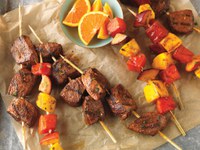Prairie Fare: Where’s the Protein?
(Click an image below to view a high-resolution image that can be downloaded)
By Julie Garden-Robinson, Food and Nutrition Specialist
NDSU Extension
“If you have ‘helpers’ put them to work,” the article said.
“We warn you, you’ll have to grin and bear it the first few times you try putting your family to work,” it continued. “More trouble than the work’s worth, you’ll think.”
“But you’ll change your mind once you get them trained,” the article concluded. “They’ll not only help you a lot, there’ll be a more cooperative spirit about everything, especially if you’re generous with praise.”
I was flipping through some World War II-era cookbooks in my office. They dated back to 1943 and were written by the Home Economics Institute. They included information about stretching your protein dollar and using your victory garden produce in a variety of ways. They also had some parenting advice, I noted.
Despite the books being 77 years old and a bit fragile, much of the advice was good.
I think my mother must have read these books.
Thinking back, I was the one who was grinning and bearing it when I was a child. To be honest, I wasn’t always grinning as I cleaned, watered plants and helped with dishes.
“I’ve never seen such a good worker,” Mom said.
Yes, she read the part about the value of praise. I worked even harder.
In the World War I and II eras, victory gardens provided food for families, who also were encouraged to preserve foods. Much of the agricultural production during the war was diverted to other parts of the world to offset food shortages.
Not only did the gardens provide nutritious food, they boosted morale. In 1943, meat, cheese, fats, canned milk and some processed foods were rationed in the U.S. People were allotted points in ration books for various foods.
Despite the war being over for a few decades when I was young, we had “victory gardens” covering our backyard and side yard, plus another garden in the country.
Lately, we have a different type of war going on: a battle against a virus. Sadly, this virus is causing illness and death, especially among older generations.
Most of us have heard about recent concerns of food shortages. We might have experienced higher costs of meat items or limits on the amount of meat and other protein foods we can purchase. Many meat packing plants have shut down temporarily.
As I strolled to the meat counter in the grocery store near my home recently, I didn’t encounter a shortage.
If the meat supply is limited where you are, buying meat from local sources is an option in some communities. We also can learn from previous generations, who stretched protein by adding beans, lentils and other foods.
We all need protein as part of a nutritious, well-balanced diet, regardless of our age. We need protein to build and repair tissues throughout our body.
How much protein do we need, according to the current nutrition research? It might be less than you think.
Try this calculation to learn the number of grams of protein you need. Multiply your body weight (in pounds) by 0.36 gram. On average, a sedentary man weighing 180 pounds would need about 65 grams of protein per day to meet basic needs. If you are more active or ill, your protein needs usually increase.
Grams are the units of weight and are used on Nutrition Facts labels. An ounce of pure protein would weigh 28 grams. Foods, however, are mixtures of protein, fat and carbohydrates.
Here are some examples to help you add up the protein you eat. A 3-ounce hamburger patty has 28 grams of protein, a 3-ounce piece of chicken has 26 grams and a 3-ounce serving of pork or tuna has 22 grams. A cup of milk has 8 grams of protein, while a 6-ounce serving of Greek yogurt has 18 grams, depending on the brand.
Plant proteins, such as beans and lentils, also contribute protein to our diet. One-half cup of kidney beans, 1 ounce of peanuts, 1 ounce of string cheese or 1 tablespoon of peanut butter each contribute 7 grams of protein.
Further, one large egg has 5 grams of protein and a slice of whole-grain bread has about 4 grams of protein.
To stretch your protein dollar, try making casseroles, stir-fry, soups and other recipes with a variety of vegetables and grains mixed with meat, poultry or fish. Try adding cooked lentils to extend the meat in tacos or sloppy joes. Add more beans to chili.
Use less-tender meat cuts to make soup, stew or other recipes with slow, moist-heat cooking methods, which tenderize the meat. Using marinades also can tenderize meat for the grill.
Here is a delicious recipe for the grill from the North Dakota Beef Commission, with a 4-ounce portion of meat per person. Explore some of the value cuts available.
Citrus-marinated Kabobs
1 pound beef top sirloin steak, boneless, cut 1 inch thick
1 medium orange
1/4 cup chopped fresh cilantro
1 Tbsp. smoked paprika
1/4 tsp. ground red pepper (optional)
4 c. cubed mango, watermelon, peaches and/or plums
Salt
Grate peel and squeeze 2 tablespoons of juice from orange; reserve juice. Combine orange peel, cilantro, paprika and ground red pepper, if desired, in small bowl. Cut beef steak into 1 1/4-inch pieces. Place beef and 2 1/2 tablespoons of cilantro mixture in food-safe plastic bag; turn to coat. Place remaining cilantro mixture and fruit in separate food-safe plastic bag; turn to coat. Close bags securely. Marinate beef and fruit in refrigerator 15 minutes to two hours. Soak eight 9-inch bamboo skewers in water 10 minutes; drain. Thread beef evenly onto four skewers, leaving a small space between pieces. Thread fruit onto remaining four separate skewers. Place kabobs on grill over medium, ash-covered coals. Grill beef kabobs, covered, eight to 10 minutes (over medium heat on preheated gas grill, nine to 11 minutes) for medium rare (145 F) to medium (160 F) doneness, turning occasionally. Grill fruit kabobs five to seven minutes or until softened and beginning to brown, turning once. Season beef with salt, as desired. Drizzle reserved orange juice over fruit kabobs.
Makes four servings. Each serving has 239 calories, 6 grams (g) fat, 27 g protein, 20 g carbohydrate, 57 milligrams sodium (without added salt).
(Julie Garden-Robinson, Ph.D., R.D., L.R.D., is a North Dakota State University Extension food and nutrition specialist and professor in the Department of Health, Nutrition and Exercise Sciences. Follow her on Twitter @jgardenrobinson)
NDSU Agriculture Communication - May 21, 2020
| Source: | Julie Garden-Robinson, 701-231-7187, julie.garden-robinson@ndsu.edu |
|---|---|
| Editor: | Ellen Crawford, 701-231-5391, ellen.crawford@ndsu.edu |




